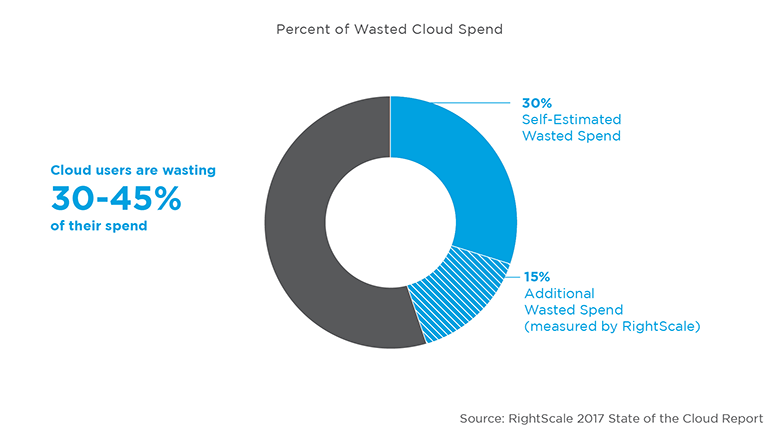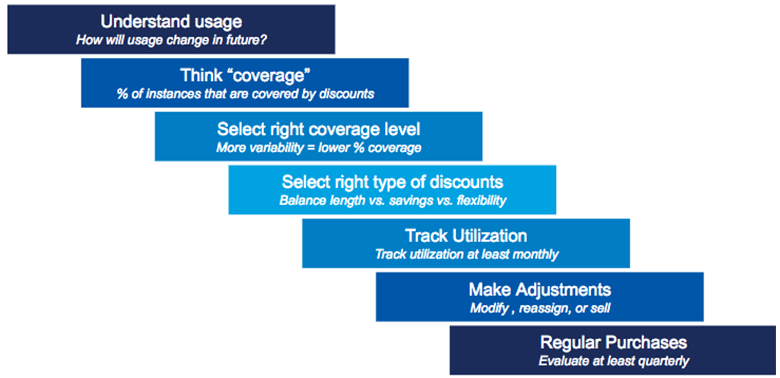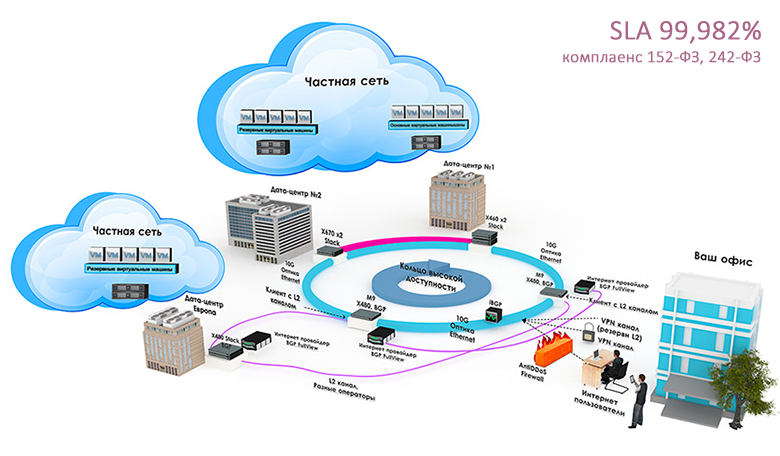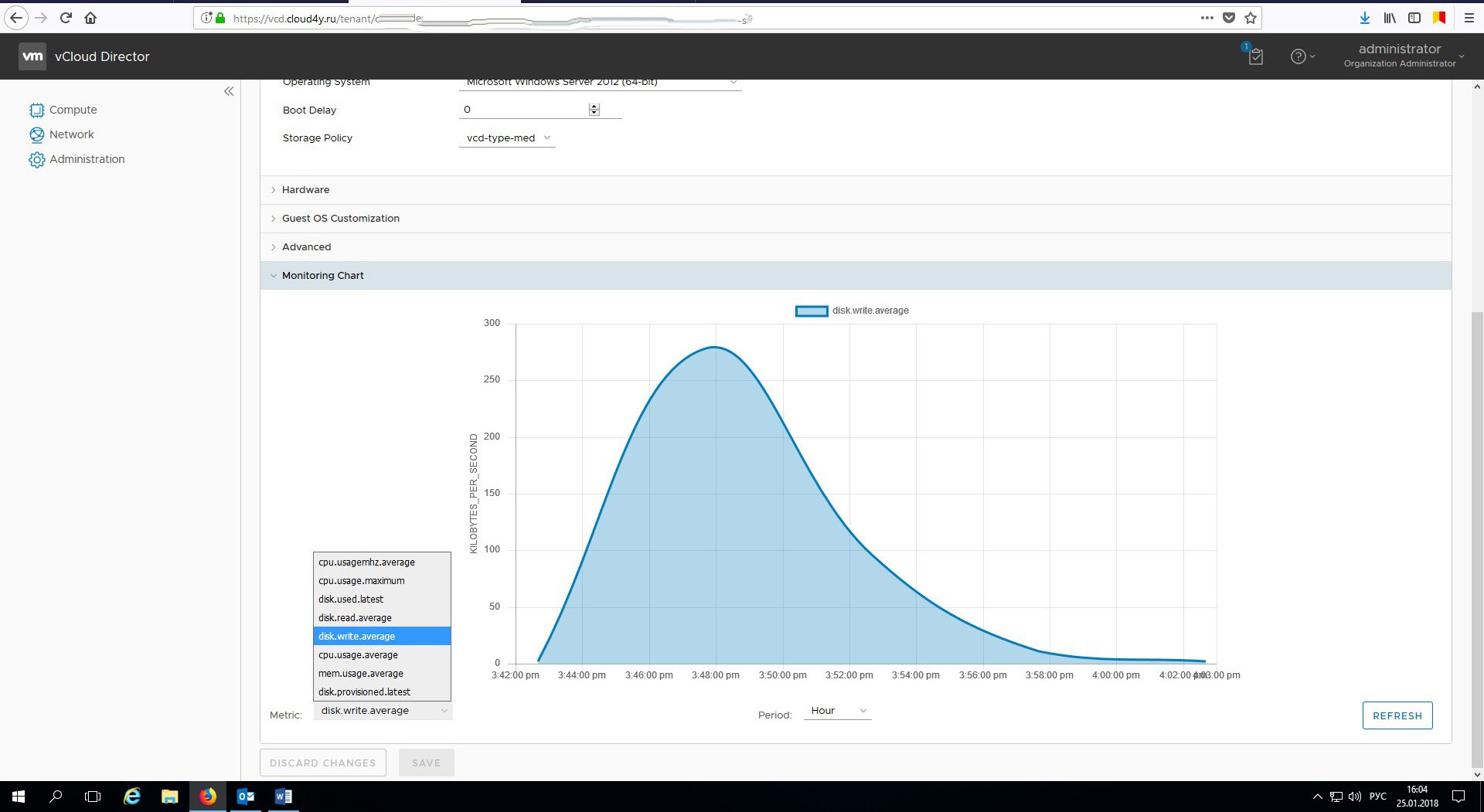How and why $ 10 billion in public cloud costs are unjustified losses
- Transfer
At the end of 2017, public cloud service providers announced their earnings for the 3rd quarter. Income indicators impress with their size and growth rate. The total revenue of three large companies (Amazon Web Services, Microsoft Azure and Google Cloud Platform) amounted to $ 7.5 billion for the third quarter or $ 30 billion per year.
10 billion dollars in cloud costs are losses
RightScale analysts wondered how much cloud provider revenue comes from tenants who do not understand how they could prevent unnecessary losses in the total cost of cloud computing. Earlier in the RightScale 2017 State of the Cloud Report, it was noted by cloud computing users that excess costs account for 30 percent of cloud costs. In fact, it is likely that this figure is even higher.

In fact, 60 preliminary cloud cost optimization evaluations that were performed for RightScale customers were reviewed before optimization work was started. It was found that the average loss in cloud costs is 35 percent. This corresponds to losses of up to $ 10 billion in costs for AWS, Azure and Google annually. It is likely that the number will grow next year, as the pace of adoption of cloud technologies is accelerating. In such circumstances, IT professionals need to identify excessive costs and take the necessary measures to save and optimize costs.
First of all, we need to recognize that overhead in IT is not a new problem. For decades, we have been buying infrastructure for data centers several months or even years before it is really needed on such a scale. And with the introduction of virtualization, companies continue to deploy virtual machines, usually with more resources than they really need, and often leave them turned on, even when they are not used for a long time.
However, the incentive to increase the efficiency of virtualized environments is slightly higher, since the advantage of optimization seems less tangible when the equipment is already purchased and fully paid.
The difference in the case of the public cloud is that resource optimization begins to make money right away. The moment you turn off the resource or reduce the amount of resources consumed, you will no longer pay for excess and at the end of the month the bill for the cloud will be lower. So, now there is a motivation to save money and there is an opportunity to get almost instant satisfaction when you do this.
There are three factors that in some cases lead to losses in the composition of cloud costs:
The first reason a loss of this magnitude can occur in a public cloud is due to the incredible complexity of pricing and billing in the clouds. You need to “get a degree” in cloud pricing in order to understand all the features and keep track of what the money is spent on. To illustrate the scope of the problem, here are a few examples:
In addition to the pricing complexity described above, changes are constantly taking place in your cloud service costs. Changes can occur not only in the volume and structure of the resources you use, but also from the side of cloud providers who change prices, develop discount models and add new services with completely new prices. It is also important to note that providers sometimes change the way cost items are presented in a payment invoice, disrupting the automated processes that customers could implement to distribute costs and analyze the invoice.
The third reason for the losses arises from the upward introduction of the cloud. The cloud allows companies to be more flexible. Individual development teams or business units can instantly access the infrastructure they need by clicking a button or calling a simple API. You no longer have to go through the lengthy approval or allocation procedures that were required in traditional data centers.
However, resource-provisioning professionals often do not have sufficient justification for the efficient use of cloud resources. Prices for individual virtual machines or resources seem small, but only until the volume of cloud use has increased, and the cost of the cloud has not become significant. When certain values are reached, business and employees realize how losses accumulate. Even when they are aware of the problem, the lack of experience in cloud pricing and the lack of visibility in the structure of cloud costs make it difficult to solve the problem.
Most enterprises have centralized cloud teams that work to reduce the cost of cloud computing, making the use of cloud technology more efficient. But in order for the changes to take effect, such professionals must work closely with business users to determine which specific actions to take.
The three widest areas for finding sources of savings on cloud computing are instances, discounts, and data storage.
The largest share in cloud costs, and therefore the largest opportunity for losses, is instances or virtual machines.
Another important saving opportunity is to use discounts from cloud providers. Each provider has different rules and approaches to providing discounts, but the basic principles are the same. RightScale offers a step-by-step plan and action when looking for a discount option.

The size of the discount and the scheme of receipt depend on the cloud provider. The table below summarizes some of the AWS, Azure, and Google discount terms.
Storage costs typically amount to 10-25 percent of the cloud service bill; storage can grow rapidly and inflate costs. RightScale highlights the following significant opportunities for optimizing storage costs:
Organizations implementing cloud technologies quickly realize that they need to learn how to manage the costs of cloud services. Enterprises that already make extensive use of cloud technology are striving to optimize costs and use automated policies to keep them in check. Cloud tenants need reports and controls to help prevent losses before this happens. One of the optimization tools is RightScale Optima, however, it is suitable only when choosing a foreign cloud provider.
The virtualization platform supports not only the creation of the required number of virtual machines with the necessary characteristics and operating systems, but also the virtualization of networks and storage systems. Thanks to this, cloud tenants can integrate cloud servers on the network with any topology and achieve exact compliance of IT resources with their current business needs. The hardware of the provider’s platform is located in several Russian TIER III data centers. Optical communication channels between the data centers of the cloud are duplicated, forming a ring of high availability.

Cloud4Y transforms physical computing and storage resources into virtual pools. This shared pool represents a level of abstraction from which resources can be obtained for consumption by end users as separate computing units. Since management is done through the vCloud Director 9.0 self-service panel, the tenant himself can make changes to his “prefabricated” cloud data center at any time. For this reason, when using the Cloud4Y cloud, clients do not have a problem with choosing an instance type from those predefined by the provider and a problem with making changes to their cloud configuration.
Clients can view the statistics of their VMs themselves through the Tenant Portal using the 'Monitoring Chart'. vCloud Director collects and stores various VM performance metrics. These metrics include data on CPU / memory / storage utilization of the virtual machine, average latency of disk operations, and more. Monitoring and VM metrics can be used by you to make fact-based cost optimization decisions to maximize the benefits within your resources.

We are not Google, this has its advantages. Cloud4Y provides a slightly different payment model, different from the instances - the Pay as you go model for each type of resource separately.Such a more approach makes it possible to pay for resources upon consumption. It is worth noting that in all cases, the charge for CPU and RAM is taken only for the “on” time, at the time when you are not using the virtual machine - the fee is not charged, but the storage will have to be paid regardless of whether the machine is turned on or off - the fee is taken until the disk has data, if the disk is blank - the fee is not charged.
On the site you can find a calculator of the cost of services, but it is worth noting that it works on the basis of the assumption of using VM in 24x7x30 mode. Using an instance in the 12x5x30 mode, the cost of the service for you can be lower by more than 60%.
A 100% return of unused funds from the Customer’s personal account and postpayment upon consumption at the end of the month for legal entities is provided. For customers from Russia, payment is in rubles, and Russian-speaking technical support is in 24x7x365 mode.
There is a flexible system of discounts, mainly depending on the amount of resources used. If your company is engaged in development and wants to get a virtual cloud server (IaaS) service with a 40% discount, then fill out a short form and enter the promo code: “developer40”. The offer can be used by any company registered in the Russian Federation, the main activity of which falls into the category "Software development and consulting in this area."
10 billion dollars in cloud costs are losses
RightScale analysts wondered how much cloud provider revenue comes from tenants who do not understand how they could prevent unnecessary losses in the total cost of cloud computing. Earlier in the RightScale 2017 State of the Cloud Report, it was noted by cloud computing users that excess costs account for 30 percent of cloud costs. In fact, it is likely that this figure is even higher.

In fact, 60 preliminary cloud cost optimization evaluations that were performed for RightScale customers were reviewed before optimization work was started. It was found that the average loss in cloud costs is 35 percent. This corresponds to losses of up to $ 10 billion in costs for AWS, Azure and Google annually. It is likely that the number will grow next year, as the pace of adoption of cloud technologies is accelerating. In such circumstances, IT professionals need to identify excessive costs and take the necessary measures to save and optimize costs.
Cloud cost optimization delivers instant savings
First of all, we need to recognize that overhead in IT is not a new problem. For decades, we have been buying infrastructure for data centers several months or even years before it is really needed on such a scale. And with the introduction of virtualization, companies continue to deploy virtual machines, usually with more resources than they really need, and often leave them turned on, even when they are not used for a long time.
However, the incentive to increase the efficiency of virtualized environments is slightly higher, since the advantage of optimization seems less tangible when the equipment is already purchased and fully paid.
The difference in the case of the public cloud is that resource optimization begins to make money right away. The moment you turn off the resource or reduce the amount of resources consumed, you will no longer pay for excess and at the end of the month the bill for the cloud will be lower. So, now there is a motivation to save money and there is an opportunity to get almost instant satisfaction when you do this.
3 factors that inflate cloud costs
There are three factors that in some cases lead to losses in the composition of cloud costs:
- the complexity of cloud pricing and billing,
- constant change in prices and product portfolio of cloud providers and
- decentralization when using the cloud.
1. The complexity of cloud pricing and payment invoices
The first reason a loss of this magnitude can occur in a public cloud is due to the incredible complexity of pricing and billing in the clouds. You need to “get a degree” in cloud pricing in order to understand all the features and keep track of what the money is spent on. To illustrate the scope of the problem, here are a few examples:
- Cloud service accounts can often have millions of line items. Do not even expect that when you open in your favorite spreadsheet editor, the account will always be of a reasonable size.
- Cloud providers offer hundreds of thousands of price points. One AWS has over 70,000 instance-only price points.
- Cloud tenants do not have a clear idea of which option is the most affordable. When providing resources in the cloud, users often don’t know which regions or types of instances that meet their needs will be offered at the lowest price.
- There are many discount options. AWS offers reserved instances, with over 90 percent of the price offers having different discount options. Azure also added the ability to purchase reserved instances of virtual machines and pricing works differently than on AWS. Google has its own automated approach to providing two types of discounts: Sustained Use Discounts (increasing discount for the constant use of the instance more than 25% of the time per month) and Committed Use Discounts (discount on the instance reserved for 1 or 3 years).
2. Constant changes of services by cloud providers
In addition to the pricing complexity described above, changes are constantly taking place in your cloud service costs. Changes can occur not only in the volume and structure of the resources you use, but also from the side of cloud providers who change prices, develop discount models and add new services with completely new prices. It is also important to note that providers sometimes change the way cost items are presented in a payment invoice, disrupting the automated processes that customers could implement to distribute costs and analyze the invoice.
3. Decentralized use of the cloud
The third reason for the losses arises from the upward introduction of the cloud. The cloud allows companies to be more flexible. Individual development teams or business units can instantly access the infrastructure they need by clicking a button or calling a simple API. You no longer have to go through the lengthy approval or allocation procedures that were required in traditional data centers.
However, resource-provisioning professionals often do not have sufficient justification for the efficient use of cloud resources. Prices for individual virtual machines or resources seem small, but only until the volume of cloud use has increased, and the cost of the cloud has not become significant. When certain values are reached, business and employees realize how losses accumulate. Even when they are aware of the problem, the lack of experience in cloud pricing and the lack of visibility in the structure of cloud costs make it difficult to solve the problem.
Most enterprises have centralized cloud teams that work to reduce the cost of cloud computing, making the use of cloud technology more efficient. But in order for the changes to take effect, such professionals must work closely with business users to determine which specific actions to take.
Where are the biggest losses in cloud costs?
The three widest areas for finding sources of savings on cloud computing are instances, discounts, and data storage.
Instances
The largest share in cloud costs, and therefore the largest opportunity for losses, is instances or virtual machines.
- Instances with redundant resources: on average, according to RightScale Optima, 56% of the cost goes to virtual machines. However, typically 40 percent of instances are two to three times the size of what is required for current workloads. This means 50-75 percent of the extra cost for each non-optimized instance. Typical cost savings are 20–30 percent of virtual machine costs, or 11–16 percent of total cloud costs.
- Easy-to-use virtual machines: many cloud users launch their cloud servers in 24x7 mode, even if they are used only on certain hours and days. A typical example is the cloud infrastructure, which is only needed on weekdays when developers work. Using scripts to switch these instances from a 24x7 schedule to a 12x5 schedule saves 64 percent of this type of cost. Likewise, the virtual machines needed for development, QA, training, demonstrations, and other temporary applications are often not turned off after the project is completed. Switching them off immediately during periods of inactivity can cause significant savings.
- Choosing an instance type or region (essentially a data center) with a higher price: many cloud computing users do not realize that choosing neighboring regions can result in significant savings depending on the type of instance selected. For example, from AWS regions in the United States, Northern California is more expensive than Oregon. Azure has several regions on the east coast of the USA, and prices vary for many families of virtual machines. In addition, as cloud service providers offer new types of instances, they often have better specifications and cost less than the instances they replaced. Shutting down legacy virtual machine families can save you a lot of money. Choosing the best option on average gives savings of 3-5 percent of the cost of the cloud.
Instance discounts
Another important saving opportunity is to use discounts from cloud providers. Each provider has different rules and approaches to providing discounts, but the basic principles are the same. RightScale offers a step-by-step plan and action when looking for a discount option.

The size of the discount and the scheme of receipt depend on the cloud provider. The table below summarizes some of the AWS, Azure, and Google discount terms.
| Aws | Azure | |
A type | Reserved Instance | Reserved Instance | Sustained Use Discounts (for duration of use), Committed Use Discounts |
Period | 1 or 3 years | 1 or 3 years | 1 or 3 years |
Amount of discount | 20-75% |
| 37-55% |
Opportunity to change | Standard : Change the AZ (zone), network type. Without the ability to change the region or family of virtual machines. Convertible : Any changes | any changes
| Change the family or type of instance. Without the ability to change the region. |
The opportunity to return the money | Self-sale to another user (may be difficult) | Refund for 12% payment | No compensation options |
Data storage
Storage costs typically amount to 10-25 percent of the cloud service bill; storage can grow rapidly and inflate costs. RightScale highlights the following significant opportunities for optimizing storage costs:
- Unattached volumes: Volumes (disks) attached to an instance are often not deleted along with the complete removal of the virtual machine. This data is accumulated. As a result, volumes that are not attached to existing virtual machines can occupy a significant amount of storage. An administrator needs to identify and delete unattached volumes or provide automatic actions based on storage policy.
- Old snapshots: created snapshots (snapshots of the state of data in the storage system, fixed at a certain point in time) also often do not clear. Each organization has policies that describe how long to keep snapshots. Often an effective solution is to automate these actions.
- A selection of expensive storage options. Often, cloud computing users choose more expensive drives (SSD vs HDD), backup options and frequency.
Manage and optimize cloud computing costs
Organizations implementing cloud technologies quickly realize that they need to learn how to manage the costs of cloud services. Enterprises that already make extensive use of cloud technology are striving to optimize costs and use automated policies to keep them in check. Cloud tenants need reports and controls to help prevent losses before this happens. One of the optimization tools is RightScale Optima, however, it is suitable only when choosing a foreign cloud provider.
comment Cloud4Y
Disclaimer: This article was translated by Cloud4Y, a cloud-based provider offering a competing product.Cloud Cloud4Y built on VMware virtualization technology stack with support for all cluster options ( the HA, the DRS, vMotion ), and corresponds to the concept of software defined data center (SDDC). Tenants can independently create their own virtual data center (vDC) and change its configuration as soon as possible using a single and convenient control panel vCloud Director 9.0.
The virtualization platform supports not only the creation of the required number of virtual machines with the necessary characteristics and operating systems, but also the virtualization of networks and storage systems. Thanks to this, cloud tenants can integrate cloud servers on the network with any topology and achieve exact compliance of IT resources with their current business needs. The hardware of the provider’s platform is located in several Russian TIER III data centers. Optical communication channels between the data centers of the cloud are duplicated, forming a ring of high availability.

Cloud4Y transforms physical computing and storage resources into virtual pools. This shared pool represents a level of abstraction from which resources can be obtained for consumption by end users as separate computing units. Since management is done through the vCloud Director 9.0 self-service panel, the tenant himself can make changes to his “prefabricated” cloud data center at any time. For this reason, when using the Cloud4Y cloud, clients do not have a problem with choosing an instance type from those predefined by the provider and a problem with making changes to their cloud configuration.
Clients can view the statistics of their VMs themselves through the Tenant Portal using the 'Monitoring Chart'. vCloud Director collects and stores various VM performance metrics. These metrics include data on CPU / memory / storage utilization of the virtual machine, average latency of disk operations, and more. Monitoring and VM metrics can be used by you to make fact-based cost optimization decisions to maximize the benefits within your resources.

We are not Google, this has its advantages. Cloud4Y provides a slightly different payment model, different from the instances - the Pay as you go model for each type of resource separately.Such a more approach makes it possible to pay for resources upon consumption. It is worth noting that in all cases, the charge for CPU and RAM is taken only for the “on” time, at the time when you are not using the virtual machine - the fee is not charged, but the storage will have to be paid regardless of whether the machine is turned on or off - the fee is taken until the disk has data, if the disk is blank - the fee is not charged.
On the site you can find a calculator of the cost of services, but it is worth noting that it works on the basis of the assumption of using VM in 24x7x30 mode. Using an instance in the 12x5x30 mode, the cost of the service for you can be lower by more than 60%.
A 100% return of unused funds from the Customer’s personal account and postpayment upon consumption at the end of the month for legal entities is provided. For customers from Russia, payment is in rubles, and Russian-speaking technical support is in 24x7x365 mode.
There is a flexible system of discounts, mainly depending on the amount of resources used. If your company is engaged in development and wants to get a virtual cloud server (IaaS) service with a 40% discount, then fill out a short form and enter the promo code: “developer40”. The offer can be used by any company registered in the Russian Federation, the main activity of which falls into the category "Software development and consulting in this area."
